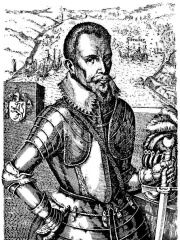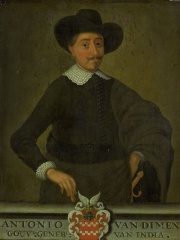
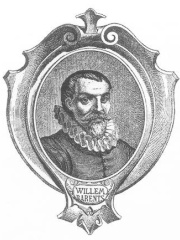
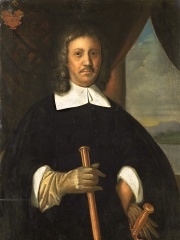
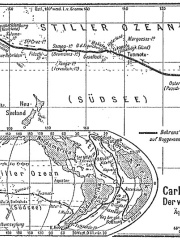
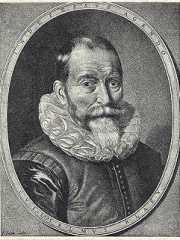
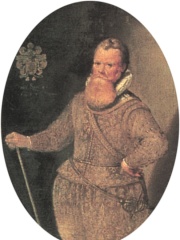
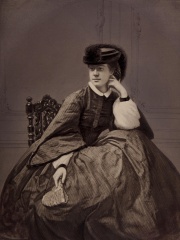
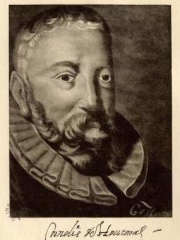
The Most Famous
EXPLORERS from Netherlands
This page contains a list of the greatest Dutch Explorers. The pantheon dataset contains 498 Explorers, 15 of which were born in Netherlands. This makes Netherlands the birth place of the 10th most number of Explorers behind Norway, and Italy.
Top 10
The following people are considered by Pantheon to be the top 10 most legendary Dutch Explorers of all time. This list of famous Dutch Explorers is sorted by HPI (Historical Popularity Index), a metric that aggregates information on a biography's online popularity. Visit the rankings page to view the entire list of Dutch Explorers.

1. Abel Tasman (1603 - 1659)
With an HPI of 79.90, Abel Tasman is the most famous Dutch Explorer. His biography has been translated into 100 different languages on wikipedia.
Abel Janszoon Tasman (Dutch: [ˈaːbəl ˈjɑnsoːn ˈtɑsmɑn]; 1603 – 10 October 1659) was a Dutch seafarer and explorer, best known for his voyages of 1642 and 1644 in the service of the Dutch East India Company (VOC). He was the first European to reach New Zealand, which he named Staten Landt. He was also the eponym of Tasmania. Likely born in 1602 or 1603 in Lutjegast, Netherlands, Tasman started his career as a merchant seaman and became a skilled navigator. In 1633, he joined the VOC and sailed to Batavia, now Jakarta, Indonesia. He participated in several voyages, including one to Japan. In 1642, Tasman was appointed by the VOC to lead an expedition to explore the uncharted regions of the Southern Pacific Ocean. His mission was to discover new trade routes and to establish trade relations with the native inhabitants. After leaving Batavia, Tasman sailed westward to Mauritius, then south to the Roaring Forties, then eastward, and reached the coast of Tasmania, which he named Van Diemen's Land after his patron, Anthony van Diemen. He then sailed north east, and was the first European to discover the west coast of New Zealand, which he named Staten Landt. It was later renamed Nieuw Zeeland, after the Dutch province of Zeeland, by Joan Blaeu, official Dutch cartographer to the Dutch East India Company. Despite his achievements, Tasman's expedition was not entirely successful. The encounter with the Māori people on the South Island of New Zealand resulted in a violent confrontation, which left four of Tasman's men dead. He returned to Batavia without having made any significant contact with the native inhabitants or establishing any trade relations. Nonetheless, Tasman's expedition paved the way for further exploitation and colonization of Australia and New Zealand by the British. Tasman continued to serve the Dutch East India Company until his death in 1659.

2. Willem Barentsz (1550 - 1597)
With an HPI of 78.49, Willem Barentsz is the 2nd most famous Dutch Explorer. His biography has been translated into 76 different languages.
Willem Barentsz (Dutch pronunciation: [ˈʋɪləm ˈbaːrənts]; c. 1550 – 20 June 1597), anglicized as William Barents or Barentz, was a Dutch navigator, cartographer, and Arctic explorer. Barentsz went on three expeditions to the far north in search for a Northeast passage. He reached as far as Novaya Zemlya and the Kara Sea in his first two voyages, but was turned back on both occasions by ice. During a third expedition, the crew discovered Spitsbergen and Bear Island, but subsequently became stranded on Novaya Zemlya for almost a year. Barentsz died on the return voyage in 1597. The Barents Sea, among many other places, is named after him.

3. Jan van Riebeeck (1619 - 1677)
With an HPI of 75.35, Jan van Riebeeck is the 3rd most famous Dutch Explorer. His biography has been translated into 41 different languages.
Johan Anthoniszoon van Riebeeck (21 April 1619 – 18 January 1677) was a Dutch navigator, ambassador and colonial administrator of the Dutch East India Company.

4. Jacob Roggeveen (1659 - 1729)
With an HPI of 73.05, Jacob Roggeveen is the 4th most famous Dutch Explorer. His biography has been translated into 44 different languages.
Jacob Roggeveen (1 February 1659 – 31 January 1729) was a Dutch explorer who was sent to find Terra Australis and Davis Land, but instead found Easter Island (called so because he landed there on Easter Sunday). Jacob Roggeveen was the first European to find Bora Bora and Maupiti of the Society Islands, as well as Samoa. He planned the expedition along with his brother Jan Roggeveen, who stayed in the Netherlands.
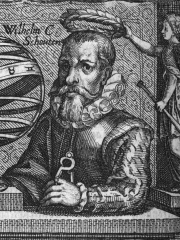
5. Willem Schouten (1567 - 1625)
With an HPI of 69.67, Willem Schouten is the 5th most famous Dutch Explorer. His biography has been translated into 32 different languages.
Willem Cornelisz Schouten (c. 1567 – 1625) was a Dutch navigator for the Dutch East India Company. He was the first to sail the Cape Horn route to the Pacific Ocean.

6. Willem Janszoon (1570 - 1631)
With an HPI of 68.59, Willem Janszoon is the 6th most famous Dutch Explorer. His biography has been translated into 37 different languages.
Willem Janszoon (Dutch: [ˈʋɪləm ˈjɑnsoːn]; c. 1570 – c. 1630) was a Dutch navigator and colonial governor. He served in the Dutch East Indies in the periods 1603–1611 and 1612–1616, including as governor of Fort Henricus on the island of Solor. During his voyage of 1605–1606, Janszoon and his crew became the first Europeans known to have seen and landed on the coast of Australia. His name is sometimes abbreviated to Willem Jansz, as was customary at his time, but "always pronounced in full and generally still is in the Netherlands where this bit of common knowledge is taught at school." However, the abbreviation Jansz is not the same as the now more predominant unabbreviated but identical Jansz that is a petrified form of Janszoon.

7. Frederick de Houtman (1571 - 1627)
With an HPI of 67.46, Frederick de Houtman is the 7th most famous Dutch Explorer. His biography has been translated into 29 different languages.
Frederick de Houtman (c. 1571 – 21 October 1627) was a Dutch explorer, navigator, and colonial governor who sailed on the first Dutch expedition to the East Indies from 1595 until 1597, during which time he made observations of the southern celestial hemisphere and contributed to the creation of 12 new southern constellations.

8. Alexandrine Tinné (1835 - 1869)
With an HPI of 65.00, Alexandrine Tinné is the 8th most famous Dutch Explorer. Her biography has been translated into 28 different languages.
Alexandrine "Alexine" Pieternella Françoise Tinne (17 October 1835 – 1 August 1869) was a Dutch explorer in Africa who was the first European woman to attempt to cross the Sahara. She was an early photographer.

9. Cornelis de Houtman (1565 - 1599)
With an HPI of 64.72, Cornelis de Houtman is the 9th most famous Dutch Explorer. His biography has been translated into 24 different languages.
Cornelis de Houtman (2 April 1565 – 11 September 1599) was a Dutch merchant seaman who commanded the first Dutch expedition to the East Indies. Although the voyage was difficult and yielded only a modest profit, Houtman showed that the Portuguese monopoly on the spice trade was vulnerable. A flurry of Dutch trading voyages followed, eventually leading to the displacement of the Portuguese and the establishment of a Dutch monopoly on spice trading in the East Indies.
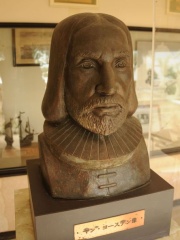
10. Jan Joosten van Lodensteijn (1556 - 1623)
With an HPI of 63.51, Jan Joosten van Lodensteijn is the 10th most famous Dutch Explorer. His biography has been translated into 15 different languages.
Jan Joosten van Lodensteyn (or Lodensteijn; 1556–1623), known in Japanese as Yayōsu (耶楊子), was a Dutch navigator and trader. Jan Joosten was a native of Delft and one of the first Dutchmen in Japan, and the second mate on the Dutch ship De Liefde, which was stranded in Japan in 1600. He remained in Japan and served as a diplomatic advisor and interpreter to the Tokugawa shogunate on trade and economic matters. He was also engaged in the shuinsen (朱印船, lit. 'red seal ship') trade in Asia. The current name of the area around Tokyo Station in Japan, Yaesu, derives from his Japanese name Yayōsu.
People
Pantheon has 15 people classified as Dutch explorers born between 1550 and 1835. Of these 15, none of them are still alive today. The most famous deceased Dutch explorers include Abel Tasman, Willem Barentsz, and Jan van Riebeeck.
Deceased Dutch Explorers
Go to all RankingsAbel Tasman
1603 - 1659
HPI: 79.90
Willem Barentsz
1550 - 1597
HPI: 78.49
Jan van Riebeeck
1619 - 1677
HPI: 75.35
Jacob Roggeveen
1659 - 1729
HPI: 73.05
Willem Schouten
1567 - 1625
HPI: 69.67
Willem Janszoon
1570 - 1631
HPI: 68.59
Frederick de Houtman
1571 - 1627
HPI: 67.46
Alexandrine Tinné
1835 - 1869
HPI: 65.00
Cornelis de Houtman
1565 - 1599
HPI: 64.72
Jan Joosten van Lodensteijn
1556 - 1623
HPI: 63.51
Jacob van Heemskerck
1567 - 1607
HPI: 62.18
Anthony van Diemen
1593 - 1645
HPI: 61.99

